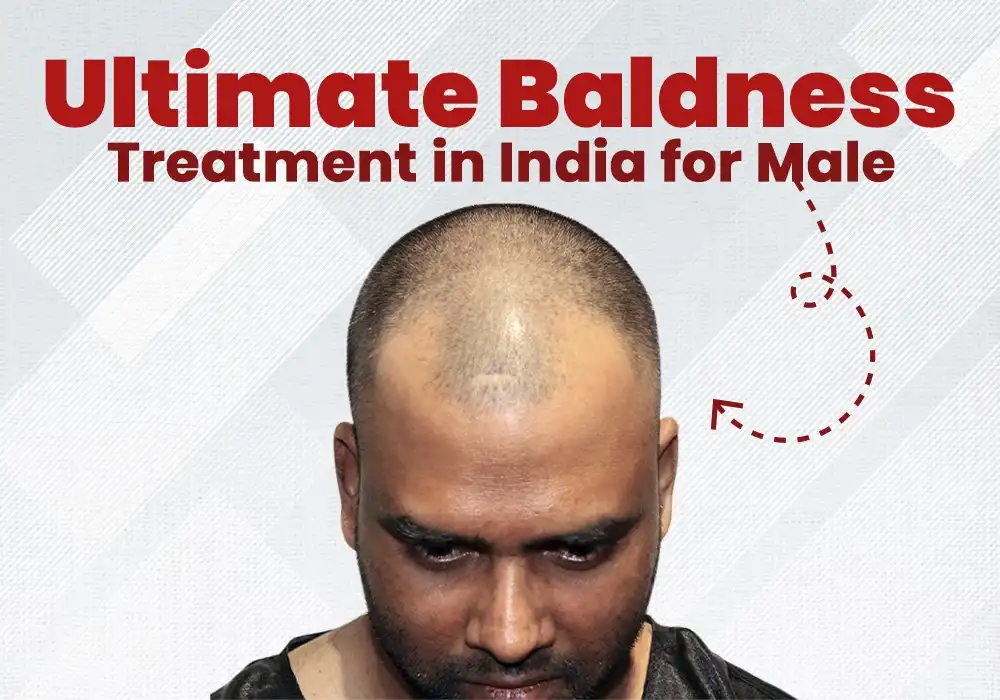Introduction
The most common cause of hair loss in men is known as Male androgenetic alopecia (male pattern baldness, MAA). MAA is associated with non-melanoma and melanoma skin care of the scalp.
MAA has several impacts on the affected person; thus, premature MAA causes emotional distress. (male pattern baldness, MAA) MAA is associated with hypertension, myocardial infarction, and hypercholesterolemia.
Everybody suffers from hair loss at some point in their life. The best baldness treatment in India for male is not just randomly using specific shampoo or lotion or just taking medicine; it is all about regaining hair naturally.
Hair loss often leads to depression and social distancing. In this article, we will discuss the best baldness treatment for male in India and its Cost, Options & Results. Let’s see
What Causes Male Pattern Baldness?
Male pattern baldness occurs when the hair follicle shrinks over time, making the hair shorter and tiny hair.
Therefore, the follicle does not grow new hair. It is still possible to grow new hair when the follicles remain alive.
Male pattern baldness depends upon male sex hormones and genes. Male pattern baldness has no side effects.
Baldness sometimes has serious causes, such as anabolic steroids, thyroid conditions, cancers, and medications. Visit your doctor when your hair loss occurs.
Visit the Best Baldness Treatment for male in India for better results.
Symptoms of baldness
The male pattern of baldness occurs in the front of the head and the hairline. The hairline moves gradually backward and forms an M shape.
The hair becomes thin on the top of the head, making it partially bald. Around the sides of the head, a U-shaped pattern is created, and a bald area is on the back of the head.
Treatments for Surgical Baldness
For men with hair loss, surgical hair restoration is optional.
Transplantation of Hair
A procedure in which a dermatological surgeon moves hair to a bald area of the head is a hair transplant. Hair transplants can be done in several ways. The most common way is grafting. There are two main techniques:
Follicular Unit Transplantation (FUT):
This surgery involves extracting hair follicles from the back or side of your scalp and using them to cover bald spots. It is faster, but it leaves a scar.

Follicular Unit Extraction (FUE):
This is a hair restoration surgery popularly known for its utility in androgenetic alopecia (AGA). FUE does not leave a linear scar but requires more time.
Both FUT and FUE hair transplants are done under anesthesia, and depending on the number of grafts transplanted, they take many hours to complete.
Hair transplants often need multiple sessions to complete. Both procedures offer similar results and are entirely natural-looking. Each follicular graft is artistically placed one by one in the thinning areas.
Treatments For Non-Surgical Baldness
PRP Therapy
Platelet-rich plasma (PRP) therapy involves injecting PRP into the patient’s scalp with a small needle to stimulate hair growth. This treatment requires multiple sessions. The growth factors help to stimulate new hair follicles.
Platelets are a part of the blood that allows your body to clot. In PRP, blood is spun in a centrifuge, and it separates into platelet-poor plasma (PPP) and platelet lysate (PL). PRP is used to treat sports injuries, knee osteoarthritis, and hair loss.
The doctor starts with three treatments. After a few months, your hair will grow thicker and fuller than before. Later, when hair growth starts to slow down, a booster treatment is needed for six months.
Laser Therapy
Laser therapy stimulates cell growth to treat hair loss. This treatment can be done at home with a laser comb. In non-surgical hair restoration treatment, low-intensity light stimulates the growth of epidermal stem cells in the hair follicle.
This hair growth treatment is safe and efficient for men and has been approved. This laser boosts blood flow to hair roots and supplies nutrients for hair growth. These lasers don’t hurt.
Most of the people like treatment at home. This treatment will not help if you are completely bald.
Cost of Hair Loss Treatment in India
- The cost of the FUE treatment method in India starts at RS 40,000, while different treatment techniques can cost up to RS 1,30,000 or more. The cost of one graft in India ranges from RS. 50 to RS.180 or more, including tax.
- The cost of the FUT treatment method in India ranges from Rs. 20 to Rs 120 per Graft, with GST Taxes.
- Laser therapy with laser devices costs around 20,000 to 50,000 or more at home.
- PRP therapy costs Rs. 10,000 to 20,000 per session, with 3-4 sessions typically needed.
- Medications cost a few hundred rupees per month for Minoxidil and Finasteride.
- Hair transplant, for one session, costs Rs. 1 to 2 lakhs with 1500 to 3000 grafts transplanted for one session. Multiple sessions are often required.
The number of transplants needed is based on the degree of baldness. Usually, one graft contains three hair follicles. So to estimate the cost of hair transplantation in India, the patient must know how many grafts will be used. To determine the best treatment, consult a qualified dermatologist for an accurate cost estimate.
Results and options
Different results for baldness treatment depend on the individual and the type of treatment. As hair growth takes time, it is important to be patient and have expectations.
Visiting your doctor regularly is also important to monitor progress and make any necessary adjustments to the treatment plan if required. Many options may include treatments like hair transplant surgery, lifestyle modifications, oral medications, and minoxidil.
1. Hair transplant:
There are multiple sessions required for optimal density. It provides permanent, natural-looking results, and it can take many months to get good results of transplanted hair growth.
2. PRP therapy:
The results of this therapy are variable, and multiple sessions are required if needed. It helps to regrow hair in some patients.
3. Laser therapy:
This therapy's results are modest; it stimulates hair growth and improves hair density.
4. Medications:
The results show gradual improvement and are required to be used for the long term.





